A cdc5+ homolog of a higher plant, Arabidopsis thaliana
- PMID: 8917598
- PMCID: PMC24100
- DOI: 10.1073/pnas.93.23.13371
A cdc5+ homolog of a higher plant, Arabidopsis thaliana
Abstract
We cloned and characterized a cDNA corresponding to a cdc5+ homolog of the higher plant, Arabidopsis thaliana. The cDNA, named AtCDC5 cDNA, encodes a polypeptide of 844 amino acid residues. The amino acid sequence of N-terminal one-fourth region of the predicted protein bears significant similarity to that of Schizosaccharomyces pombe Cdc5 and Myb-related proteins. Overexpression of the AtCDC5 cDNA in S. pombe cells is able to complement the growth defective phenotype of a cdc5 temperature-sensitive mutant. These results indicate that the AtCDC5 gene is a plant counterpart of S. pombe cdc5+. This is the first report of a cdc5(+)-like gene in a multicellular organism. We also demonstrated that a recombinant AtCDC5 protein possesses a sequence specific DNA binding activity (CTCAGCG) and the AtCDC5 gene is expressed extensively in shoot and root meristems. In addition, we cloned a PCR fragment corresponding to the DNA binding domain of human Cdc5-like protein. These results strongly suggest that Cdc5-like protein exists in all eukaryotes and may function in cell cycle regulation.
Figures
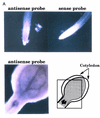


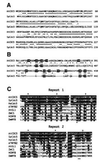
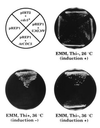
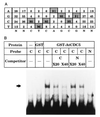
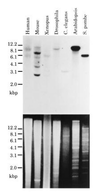
Similar articles
-
The Schizosaccharomyces pombe cdc5+ gene encodes an essential protein with homology to c-Myb.EMBO J. 1994 Jan 15;13(2):471-83. doi: 10.1002/j.1460-2075.1994.tb06282.x. EMBO J. 1994. PMID: 8313892 Free PMC article.
-
Myb-related Schizosaccharomyces pombe cdc5p is structurally and functionally conserved in eukaryotes.Mol Cell Biol. 1998 Jul;18(7):4097-108. doi: 10.1128/MCB.18.7.4097. Mol Cell Biol. 1998. PMID: 9632794 Free PMC article.
-
A cDNA homologue of Schizosaccharomyces pombe cdc5(+) from the mushroom Lentinula edodes: characterization of the cDNA and its expressed product.Biochim Biophys Acta. 2004 Oct 21;1680(2):93-102. doi: 10.1016/j.bbaexp.2004.08.009. Biochim Biophys Acta. 2004. PMID: 15488989
-
A novel myb-related gene from Arabidopsis thaliana.FEBS Lett. 1996 Jan 29;379(2):117-21. doi: 10.1016/0014-5793(95)01461-6. FEBS Lett. 1996. PMID: 8635574
-
MYB transcription factors in plants.Trends Genet. 1997 Feb;13(2):67-73. doi: 10.1016/s0168-9525(96)10049-4. Trends Genet. 1997. PMID: 9055608 Review.
Cited by
-
The Evolutionary History of R2R3-MYB Proteins Across 50 Eukaryotes: New Insights Into Subfamily Classification and Expansion.Sci Rep. 2015 Jun 5;5:11037. doi: 10.1038/srep11037. Sci Rep. 2015. PMID: 26047035 Free PMC article.
-
The Content of Anthocyanins in Cowpea (Vigna unguiculata (L.) Walp.) Seeds and Contribution of the MYB Gene Cluster to Their Coloration Pattern.Plants (Basel). 2023 Oct 20;12(20):3624. doi: 10.3390/plants12203624. Plants (Basel). 2023. PMID: 37896090 Free PMC article.
-
AthaMap: an online resource for in silico transcription factor binding sites in the Arabidopsis thaliana genome.Nucleic Acids Res. 2004 Jan 1;32(Database issue):D368-72. doi: 10.1093/nar/gkh017. Nucleic Acids Res. 2004. PMID: 14681436 Free PMC article.
-
Regulation of plant innate immunity by three proteins in a complex conserved across the plant and animal kingdoms.Genes Dev. 2007 Jun 15;21(12):1484-93. doi: 10.1101/gad.1559607. Genes Dev. 2007. PMID: 17575050 Free PMC article.
-
Factors controlling cyclin B expression.Plant Mol Biol. 2000 Aug;43(5-6):677-90. doi: 10.1023/a:1006336005587. Plant Mol Biol. 2000. PMID: 11089869 Review.
References
-
- Hirayama T, Imajuku Y, Anai T, Matsui M, Oka A. Gene. 1991;105:159–165. - PubMed
Publication types
MeSH terms
Substances
Associated data
- Actions
- Actions
LinkOut - more resources
Full Text Sources
Other Literature Sources
Molecular Biology Databases

